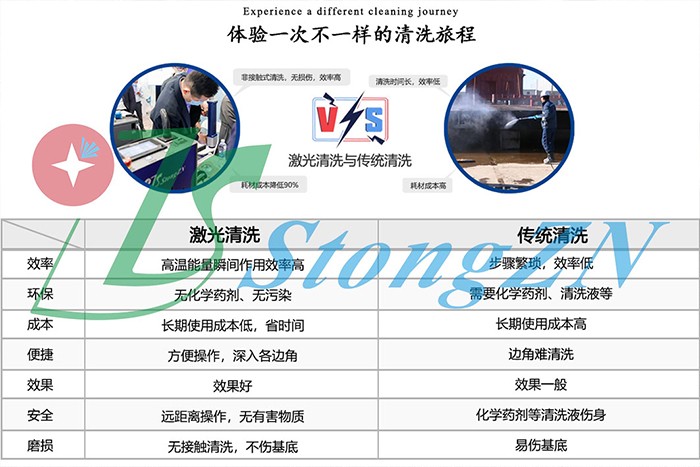What is laser cleaning?
Laser cleaning technology is a cleaning solution that uses a high-frequency short-pulse laser as the working medium. High-energy beams of light of a specific wavelength are absorbed by the rust layer, paint layer, and pollution layer, forming a rapidly expanding plasma (highly ionized unstable gas), and generating shock waves. Shock waves turn pollutants into fragments and are removed.
Current status of laser cleaning technology applications
Compared with traditional cleaning technology, laser cleaning technology has unique advantages that continue to drive the rapid development of the laser cleaning market. Traditional cleaning technologies such as dry ice cleaning, sandblasting cleaning, chemical cleaning, etc., have the drawbacks of roughness, grinding characteristics, high labor intensity, low efficiency, low safety factor, and high cost. Not only will it pollute the environment, but it may also cause harm to the human body, which is potentially dangerous. Laser cleaning technology, as a non-contact and non-abrasive cleaning process, can accurately control the depth and width of cleaning, and can achieve perfect cleaning of rust, oil, paint, and oxide layers on metal surfaces.

Application status of laser cleaning technology in the automotive field
With the continuous growth of the population and the continuous expansion of the middle class, the development of the automobile manufacturing industry is further driven. Today's cars are not only practical, but also economical and beautiful. The update speed is accelerating. Traditional cleaning methods are difficult to meet the needs of fine cleaning, environmentally friendly cleaning and low-cost cleaning in the modern automobile manufacturing industry.
In the novel cleaning process adopted by the continuous innovation of automobile technology, laser cleaning technology uses automated cleaning, selective removal, and high cleaning efficiency to remove rust, paint, oxide, and oil stains from the surface of various parts of the car, such as the wheel hub, brake pads, hood, and engine. In addition, laser cleaning is very gentle, with no consumables and no damage to the surface of the substrate, which can save enterprises a certain amount of labor costs and consumables costs every year.
The laser cleaning machine can also perform precise and precise cleaning of metal parts before welding or after welding, and at this time, the non-contact, non-grinding, and non-damage characteristics of laser cleaning can help automotive metal parts obtain strong, void-free and micro-crack welding and bonding, which can effectively improve the welding quality of automotive products, and can also perform precise and precise cleaning of designated areas of other automotive parts.
For example, laser cleaning the hood of a car: using laser cleaning technology to partially clean the hood of a car is a perfect alternative to traditional surface cleaning. Traditional cleaning methods cannot accurately clean the surface. Therefore, most car parts are now laser-cleaned, and the laser cleaning machine can also be equipped with robots or tooling fixtures to clean the surface of the workpiece in an automated manner. In addition, the operation of the laser cleaning machine is very simple, even beginners can quickly learn to use it after simple operation training.





